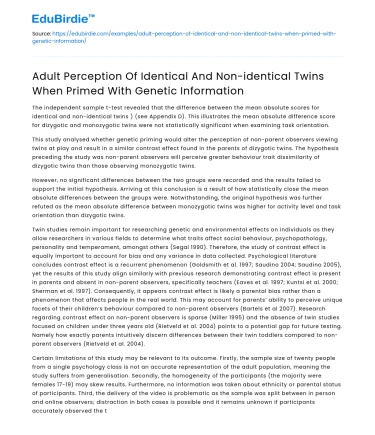The independent sample t-test revealed that the difference between the mean absolute scores for identical and non-identical twins ) (see Appendix D). This illustrates the mean absolute difference score for dizygotic and monozygotic twins were not statistically significant when examining task orientation.
This study analysed whether genetic priming would alter the perception of non-parent observers viewing twins at play and result in a similar contrast effect found in the parents of dizygotic twins. The hypothesis preceding the study was non-parent observers will perceive greater behaviour trait dissimilarity of dizygotic twins than those observing monozygotic twins.
Save your time!
We can take care of your essay
- Proper editing and formatting
- Free revision, title page, and bibliography
- Flexible prices and money-back guarantee
However, no significant differences between the two groups were recorded and the results failed to support the initial hypothesis. Arriving at this conclusion is a result of how statistically close the mean absolute differences between the groups were. Notwithstanding, the original hypothesis was further refuted as the mean absolute difference between monozygotic twins was higher for activity level and task orientation than dizygotic twins.
Twin studies remain important for researching genetic and environmental effects on individuals as they allow researchers in various fields to determine what traits affect social behaviour, psychopathology, personality and temperament, amongst others (Segal 1990). Therefore, the study of contrast effect is equally important to account for bias and any variance in data collected. Psychological literature concludes contrast effect is a recurrent phenomenon (Goldsmith et al. 1997; Saudino 2004; Saudino 2005), yet the results of this study align similarly with previous research demonstrating contrast effect is present in parents and absent in non-parent observers, specifically teachers (Eaves et al. 1997; Kuntsi et al. 2000; Sherman et al. 1997). Consequently, it appears contrast effect is likely a parental bias rather than a phenomenon that affects people in the real world. This may account for parents’ ability to perceive unique facets of their children’s behaviour compared to non-parent observers (Bartels et al 2007). Research regarding contrast effect on non-parent observers is sparse (Miller 1995) and the absence of twin studies focused on children under three years old (Rietveld et al. 2004) points to a potential gap for future testing. Namely how exactly parents intuitively discern differences between their twin toddlers compared to non-parent observers (Rietveld et al. 2004).
Certain limitations of this study may be relevant to its outcome. Firstly, the sample size of twenty people from a single psychology class is not an accurate representation of the adult population, meaning the study suffers from generalisation. Secondly, the homogeneity of the participants (the majority were females 17-19) may skew results. Furthermore, no information was taken about ethnicity or parental status of participants. Third, the delivery of the video is problematic as the sample was split between in person and online observers; distraction in both cases is possible and it remains unknown if participants accurately observed the twins’ zygosity in the instructions prior to the video.
To improve upon this experiment in the future, a larger sample of randomised participants of varying age and ethnicity from different backgrounds would potentially provide more accurate measurements regarding the existence of contrast effect. A greater emphasis would be placed on the zygosity of the twins, ensuring the participants were aware beforehand as without this information the experiment is potentially fallacious.
As this was a one-tailed hypothesis and the degree of freedom was 18, the critical value equaled 1.734 when using a significance level of a = 0.05. Considering the independent samples T-Test equaled -0.19, it was not possible to reject the null hypothesis. In conclusion, no significant difference occurred between both groups (identical and non-identical) in relation to activity level trait scale.
As this was a one-tailed hypothesis and the degree of freedom was 18, the critical value equaled 1.734 when using a significance level of a = 0.05. Considering the independent samples T-Test equaled -0.62, it was not possible to reject the null hypothesis. In conclusion, no significant difference occurred between both groups (identical and non-identical) in relation to Task Orientation trait scale.






 Stuck on your essay?
Stuck on your essay?

